It looks like you're using an Ad Blocker.
Please white-list or disable AboveTopSecret.com in your ad-blocking tool.
Thank you.
Some features of ATS will be disabled while you continue to use an ad-blocker.
share:
These examples of Sumerian stone seal impressions dating back some 5,000 years intrigue me and i'd be interested to know what others make of them if
anything, they are all considered to depict women involved in various activities and are from
here
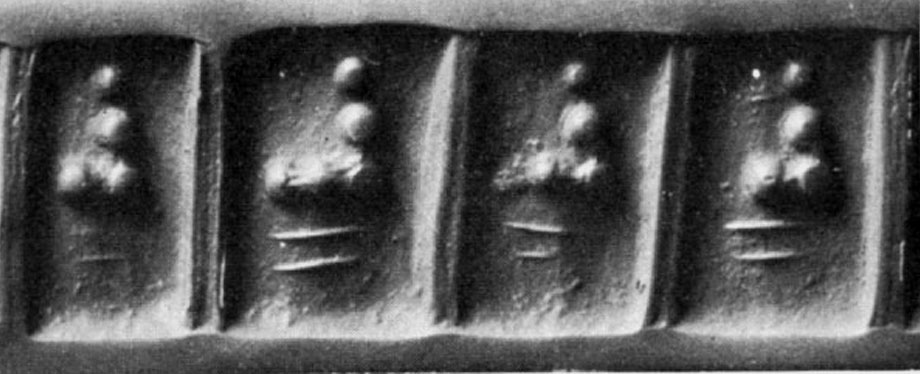
The first question for me is do these depict regular women of the period or some other form of female representation, they have something of the nymphae about them, or as in the example above the Neolithic Goddess type.

In most examples the braided pony tail hairstyle seems unusually long and pronounced, as if having some cultic significance, and the figures also often appear to have beaks, reminiscent of the bird Goddess type figurines of the period.
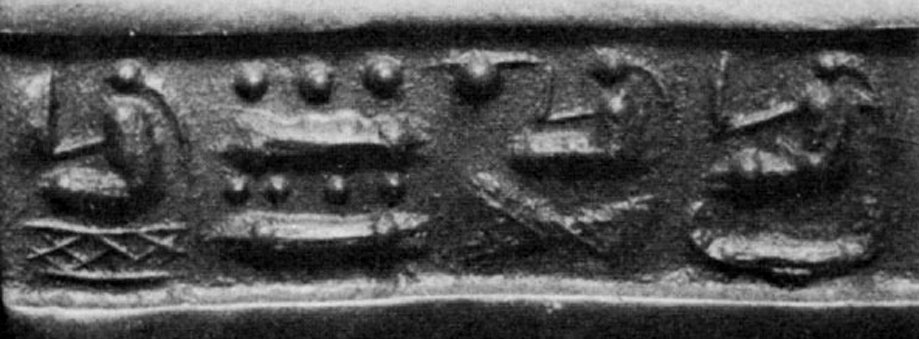
The activities they are engaged in are not always easy to make out or understand, it might be considered above that they are involved in the production of reed beds or boats which they hover above with a hand held instrument, but the relationship to the pattern of dots is enigmatic.

In the example above they seem more engaged in an act of worship than producing anything, and here their heads are seemingly rendered as the dots, which suggests a close relationship between the dots and women if nothing else.

Above they could perhaps be seen to be gathering from some strange plant, the central figure appears to have a basket reinforcing this idea, but it seems unusual there are no leaves upon the plant and it isn't depicted as normal for a flower.

Above similar is seen to the previous example, except here they hold an implement and they are perhaps engaged in spinning fabric or perhaps hitting a ritual musical instrument, it is uncertain.
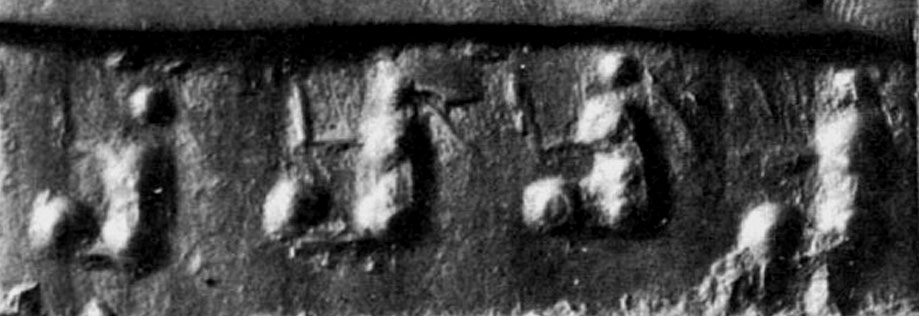
Above seems more straight forward in that they appear to be grinding the contents of a bowl placed before them, and below the concern seems to be with the making of ceramics examples of which are seen behind the figure engaged in activity.

So anyway there we have it, some interesting little seals, which unfortunately appear to have been stolen during the war in Iraq.

The first question for me is do these depict regular women of the period or some other form of female representation, they have something of the nymphae about them, or as in the example above the Neolithic Goddess type.

In most examples the braided pony tail hairstyle seems unusually long and pronounced, as if having some cultic significance, and the figures also often appear to have beaks, reminiscent of the bird Goddess type figurines of the period.

The activities they are engaged in are not always easy to make out or understand, it might be considered above that they are involved in the production of reed beds or boats which they hover above with a hand held instrument, but the relationship to the pattern of dots is enigmatic.

In the example above they seem more engaged in an act of worship than producing anything, and here their heads are seemingly rendered as the dots, which suggests a close relationship between the dots and women if nothing else.

Above they could perhaps be seen to be gathering from some strange plant, the central figure appears to have a basket reinforcing this idea, but it seems unusual there are no leaves upon the plant and it isn't depicted as normal for a flower.

Above similar is seen to the previous example, except here they hold an implement and they are perhaps engaged in spinning fabric or perhaps hitting a ritual musical instrument, it is uncertain.

Above seems more straight forward in that they appear to be grinding the contents of a bowl placed before them, and below the concern seems to be with the making of ceramics examples of which are seen behind the figure engaged in activity.

So anyway there we have it, some interesting little seals, which unfortunately appear to have been stolen during the war in Iraq.
Great thread and fantastic analysis of the images. I too noticed the ponytails but what I didn't fully grasp was that while some cultures portray
women through depictions with enlarged female traits like breasts and depictions of genitalia, in this instance I observe rounded tops and rounded
bottoms - perhaps an indicator for pregnancy. The Sumerians are one of the oldest if not the oldest culture we have on record. Hence these constructs
using various elongations of a circle intrigue me all the more. In some of the images they almost look like worker ants in the sense that each
individual depicted may not have unique traits of their own in said depiction. Very interesting gallery of images overall.
reply to post by MysteriousHusky
Yes the insect like quality with regards to the segmented form of the body and in the case were two pony tails can be sometimes seen the antennae like quality of that is what i find interesting.
I'm sure there will be religious and symbolic significance to these, as there always was on their cylinder seals, and the sense that they are as some form of collective intrigues.
Yes the insect like quality with regards to the segmented form of the body and in the case were two pony tails can be sometimes seen the antennae like quality of that is what i find interesting.
I'm sure there will be religious and symbolic significance to these, as there always was on their cylinder seals, and the sense that they are as some form of collective intrigues.
reply to post by Kantzveldt
Kamtz, you never cease to intrigue me with your finds. In looking at these, the first impression I got, was the symbolism in these was more important to the artist than anatomical correctness. Which makes me wonder if we're looking at a message we can't or aren't understanding.
Kamtz, you never cease to intrigue me with your finds. In looking at these, the first impression I got, was the symbolism in these was more important to the artist than anatomical correctness. Which makes me wonder if we're looking at a message we can't or aren't understanding.
reply to post by Kantzveldt
In the second from top seal the women are each 'working on' nine spherical objects, and every other figure is upside-down..
Wonder what the significance of that is...
In the second from top seal the women are each 'working on' nine spherical objects, and every other figure is upside-down..
Wonder what the significance of that is...
Wow! What a treasure! I couldn't find a single link to those photos other than the one you provided I could spend days there and probably will. Makes
me wonder what that war really was about...lol
As usual you post brain busters!
It will be awhile before I can re-post a coherent response, but I have a lot of ideas swimming in my head on this like why do I smell honey?
I am off maybe to dream on this...
As usual you post brain busters!
It will be awhile before I can re-post a coherent response, but I have a lot of ideas swimming in my head on this like why do I smell honey?
I am off maybe to dream on this...
edit on 25-9-2013 by abeverage because: collective dreams
reply to post by lostgirl
It's a good observation, a constellation will be seen to rotate through 180 degrees from it's rising position to it's setting, for example Gemini is seen the 'right way up' when setting in the West but is upside down when rising.
Which could indicate a constellation for those seated figures, the dots seen can also in many cases be representing stellar asterisms on seals, which reinforces that possibility.
I need to look into whether these curious bird/insect women made it into the Sumerian Pantheon in some form or whether they are a throwback from the Neolithic which faded into obscurity.
It's a good observation, a constellation will be seen to rotate through 180 degrees from it's rising position to it's setting, for example Gemini is seen the 'right way up' when setting in the West but is upside down when rising.
Which could indicate a constellation for those seated figures, the dots seen can also in many cases be representing stellar asterisms on seals, which reinforces that possibility.
I need to look into whether these curious bird/insect women made it into the Sumerian Pantheon in some form or whether they are a throwback from the Neolithic which faded into obscurity.
reply to post by abeverage
They do remind me of the Cretan Bee Goddess type representations, but as you know i have also been interested in the masked/costumed Neolithic Vinca figurines as from here, and also the hand held or flying Sar-Ur weapon as from here
So have a close look at this one...
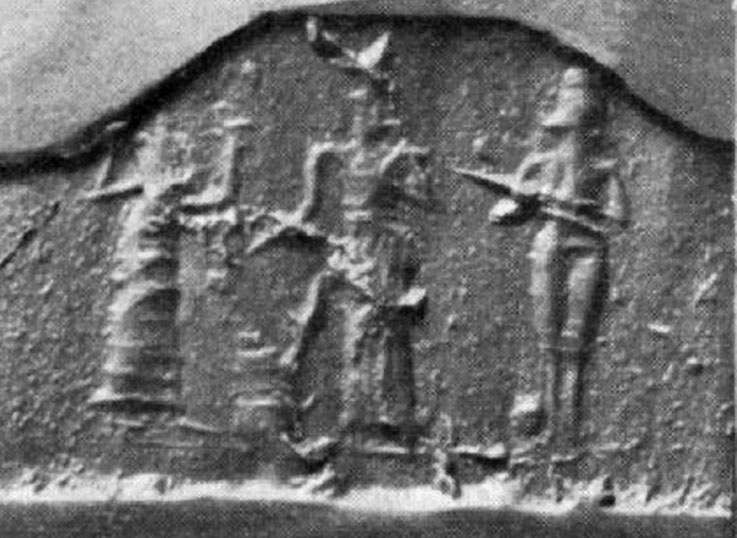
To the right we see a figure similar in lithe form to the Vinca figurines, and also slight indications of similar costume type also probably masked, and apparently holding a Sar-ur weapon.
Here again we see good indication of bird-mask type representation;
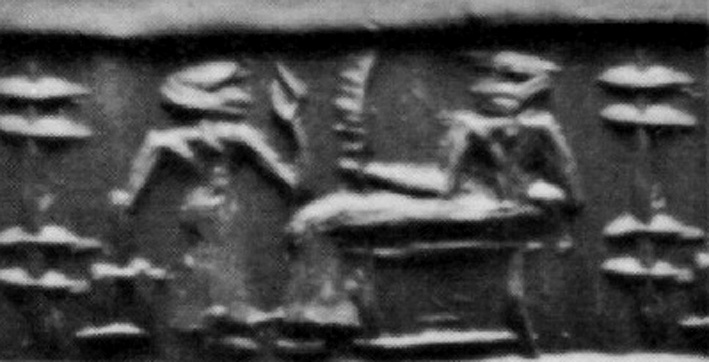
Perhaps there was taught the ways of the collective but probably they were no more bees than they were birds, behind the mask.
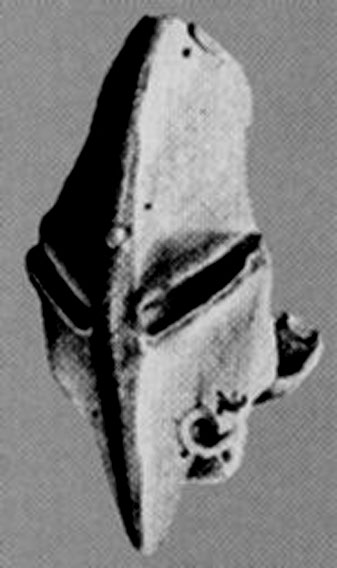
They do remind me of the Cretan Bee Goddess type representations, but as you know i have also been interested in the masked/costumed Neolithic Vinca figurines as from here, and also the hand held or flying Sar-Ur weapon as from here
So have a close look at this one...

To the right we see a figure similar in lithe form to the Vinca figurines, and also slight indications of similar costume type also probably masked, and apparently holding a Sar-ur weapon.
Here again we see good indication of bird-mask type representation;

Perhaps there was taught the ways of the collective but probably they were no more bees than they were birds, behind the mask.

edit on 26-9-2013 by Kantzveldt because: (no reason given)
Imo it is depicting the Annunaki harvesting the planets in our solar system.
I have always found ancient artwork fascinating for many reasons. Being an Artist (debatable) myself, I can appreciate most forms of art, but I have
often wondered were depictions realistic or just expressions or both?
How would we know if there was not a cubist period or impressionism movement? We often assume they depicted rituals, structures and lifestyles and events in a realistic way but how do we explain some of these?
And on the other hand what if they were trying to depict something EXACTLY how it was and yet it is something modern culture has representation of, or any known existing or extent found life forms? What if there really were Man Bulls?
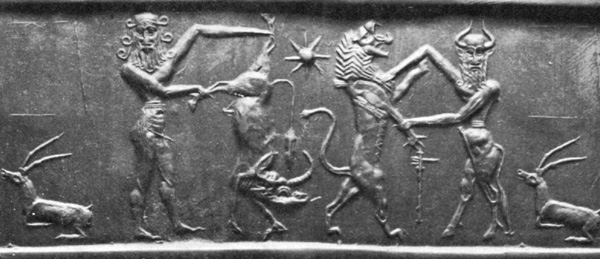
I really want to understand the Man and Man Bull depiction more as it like "The Presentation" seemed a common story and theme. Why are they dancing and playing Wheelbarrow? LOL Why does the Bull on the right appear to be stitched back together? And the 8 pointed star? I could speculate but any real guesses but as for the "known" mythology however my knowledge is lacking.
We are already messing around with Genetic engineering perhaps our previous cultures were more advance we always like to think we are at the pinnacle but what if we have been here before? Mixing Animal and Beast actually creating a Chimaera, pretty crazy must be mythological right, couldn't possibly be a realistic depiction right?

The presentation scene really shows this point there are several that look like usually 3 humans paying tribute to seated Deity. Now before I am scolded for these being ancient and faded or eroded impressions I do realize this, but often these are dated to the same time period show the same amount of wear but they are just completely different beings being represented.
Some are brilliant representations of human anatomy, but then some are stranger...and stranger almost inhuman or even robotic!
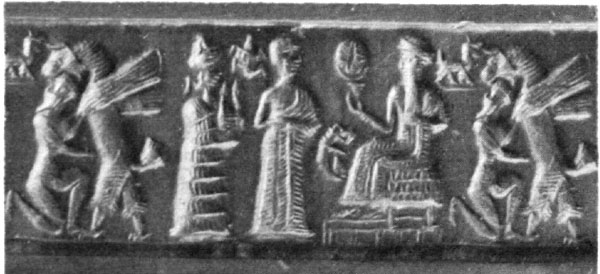
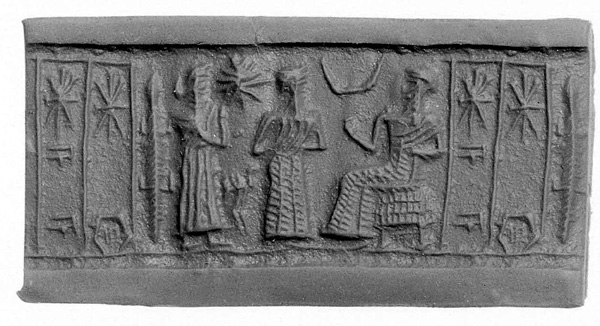
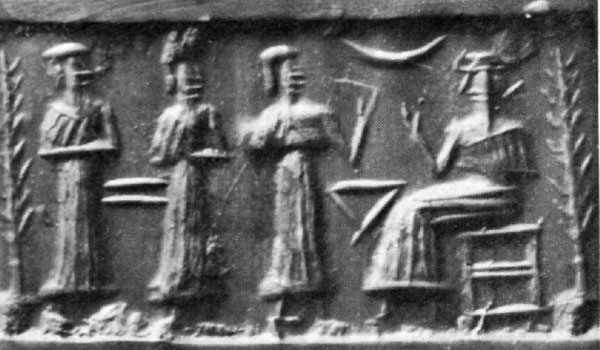
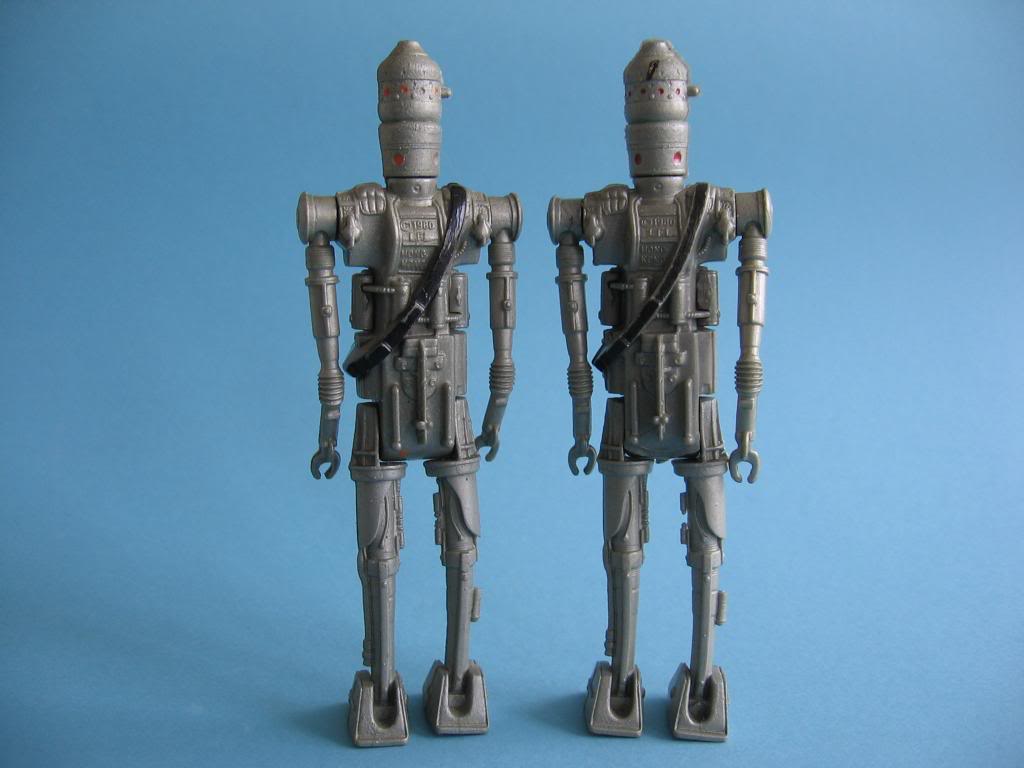
Now sure like I have said this could be due to the wear on the clay cylinders but what if it wasn't? What if our ancient ancestors were more advanced then we are today? Why is that so hard for people to come to terms with that we my not be at the peak or only that we have been here many, many times before?
Tomorrow I will add some more crazy pop culture references including some literary ones with nod to Kantz's study on the Necronomicon. But for now I need to Dream, I smell a honey like fungus among us...
How would we know if there was not a cubist period or impressionism movement? We often assume they depicted rituals, structures and lifestyles and events in a realistic way but how do we explain some of these?
And on the other hand what if they were trying to depict something EXACTLY how it was and yet it is something modern culture has representation of, or any known existing or extent found life forms? What if there really were Man Bulls?

I really want to understand the Man and Man Bull depiction more as it like "The Presentation" seemed a common story and theme. Why are they dancing and playing Wheelbarrow? LOL Why does the Bull on the right appear to be stitched back together? And the 8 pointed star? I could speculate but any real guesses but as for the "known" mythology however my knowledge is lacking.
We are already messing around with Genetic engineering perhaps our previous cultures were more advance we always like to think we are at the pinnacle but what if we have been here before? Mixing Animal and Beast actually creating a Chimaera, pretty crazy must be mythological right, couldn't possibly be a realistic depiction right?

The presentation scene really shows this point there are several that look like usually 3 humans paying tribute to seated Deity. Now before I am scolded for these being ancient and faded or eroded impressions I do realize this, but often these are dated to the same time period show the same amount of wear but they are just completely different beings being represented.
Some are brilliant representations of human anatomy, but then some are stranger...and stranger almost inhuman or even robotic!




Now sure like I have said this could be due to the wear on the clay cylinders but what if it wasn't? What if our ancient ancestors were more advanced then we are today? Why is that so hard for people to come to terms with that we my not be at the peak or only that we have been here many, many times before?
Tomorrow I will add some more crazy pop culture references including some literary ones with nod to Kantz's study on the Necronomicon. But for now I need to Dream, I smell a honey like fungus among us...
abeverage
I have always found ancient artwork fascinating for many reasons. Being an Artist (debatable) myself, I can appreciate most forms of art, but I have often wondered were depictions realistic or just expressions or both?
How would we know if there was not a cubist period or impressionism movement? We often assume they depicted rituals, structures and lifestyles and events in a realistic way but how do we explain some of these?
And on the other hand what if they were trying to depict something EXACTLY how it was and yet it is something modern culture has representation of, or any known existing or extent found life forms? What if there really were Man Bulls?
Notice if you will that the figure on the right is made up in classical centaur form but closer tp the Greek type Pan here. In my opinion this is Gilgamesh and his pal commemorative of some sort.
reply to post by Logarock
These are excellent ! I think that a lot of the cylinder seals and also tablets were deciphered but supposedly thousands were found, I wonder what has not been discovered or even worse what has been found but never disclosed to the public.
These are excellent ! I think that a lot of the cylinder seals and also tablets were deciphered but supposedly thousands were found, I wonder what has not been discovered or even worse what has been found but never disclosed to the public.
abeverage
This is an example of some sort of supplication made before the King which you may have noticed is wearing the Uruk style headgear. The small griffin behind his head is his personal or family moniker. The small figure at his knee, which is later developed into a monkey or rabbit, is the official recorder of this event.
The two standing figures are the supplicants with royal or family moniker between the two. The two man eating griffins are symbols of power, elaborations on the kings moniker. I have even seen a seal from this time period that shows a supplicant with Egyptian headgear and Scorpion moniker and it is clearly someone from that family being recognized by the king.
You will notice that these type, almost identical really, of recordings of events were later used by all the major kingdoms of the world. The seated king with chair on a block, the monkey or rabbit scribe, Thoth in Egypt, supplicants with offerings, in the same style can be found in middle america even and local to that region right on up into the Roman times.
edit on 28-9-2013 by Logarock because: n
phinubian
reply to post by Logarock
These are excellent ! I think that a lot of the cylinder seals and also tablets were deciphered but supposedly thousands were found, I wonder what has not been discovered or even worse what has been found but never disclosed to the public.
The Cuneiform Digital Library Initiative gives an estimate of 500,000 for the total number of tablets (or fragments) that have been found but the vast majority deal with accounting, a few were 'disputations' which we might consider a short story, a few on myths and fables, poetry, about law, agriculture and irrigation..and the odd recipe.
The majority of it is on line and can be found here
CDLI
You can search all known tablets and fragments here
Search
Kantzveldt
reply to post by abeverage
A little boy draws that from his close encounter.
1994 Zimbabwe
Ariel school Africa UFO kids interview then and now
www.youtube.com/watch?v=ww6uzFpKBQo
I'm gonna pop this connection in your other thread as well
Nice finds!!
I like the section with geometric patterns in the stolen collection. The crosses match up with some modern iconic crosses.
edit on 28-9-2013 by
AbleEndangered because: added: 1994 zimbabwe
Besides all the interpretation,
I noticed that the University of Chicago holds the image copyrights, and that all of these have a status of "Feared to be stolen."
Of all things relating to Chicago, ....Yes, it all makes sense now..
I noticed that the University of Chicago holds the image copyrights, and that all of these have a status of "Feared to be stolen."
Of all things relating to Chicago, ....Yes, it all makes sense now..
reply to post by Kantzveldt
This image here files.abovetopsecret.com... you said you didn't know what the plant was. What came to my mind was poppies. They look to me like poppies. Did the Sumerians use poppies, does anybody know? ** Never mind, I looked it up myself, lol They did, in fact, use the poppy plant. SO, maybe its poppies.
This image here files.abovetopsecret.com... you said you didn't know what the plant was. What came to my mind was poppies. They look to me like poppies. Did the Sumerians use poppies, does anybody know? ** Never mind, I looked it up myself, lol They did, in fact, use the poppy plant. SO, maybe its poppies.
JJRichey
reply to post by Kantzveldt
This image here files.abovetopsecret.com... you said you didn't know what the plant was. What came to my mind was poppies. They look to me like poppies. Did the Sumerians use poppies, does anybody know? ** Never mind, I looked it up myself, lol They did, in fact, use the poppy plant. SO, maybe its poppies.
Yep they used it. The Sumerians called it the Hul Gil, the "joy plant".
The impression I get is the woman is a representation of a star or a planet, and the round objects are planets or some other type of celestial
bodies..
I find most of the carved images such as these, deal with beliefs and religions of the period.. Very rarely do you find common or everyday type activities displayed in carvings.. Although I'm no expert by any means, it's just my opinion..
Interesting,, thnx OP ...
I find most of the carved images such as these, deal with beliefs and religions of the period.. Very rarely do you find common or everyday type activities displayed in carvings.. Although I'm no expert by any means, it's just my opinion..
Interesting,, thnx OP ...
new topics
-
Man Stabbed or Cardiac arrest on Westminster Bridge, London, UK
Mainstream News: 16 minutes ago -
A fix for the Trans players in sports
Social Issues and Civil Unrest: 1 hours ago -
Petition Calling for General Election at 564,016 and rising Fast
Political Issues: 4 hours ago -
Rep. Alexandria O. Cortez Says Forcing People to Use The Correct Bathroom is Dangerous.
US Political Madness: 11 hours ago
top topics
-
France gives Ukraine license to fire long-range missiles at Russia
World War Three: 16 hours ago, 9 flags -
Petition Calling for General Election at 564,016 and rising Fast
Political Issues: 4 hours ago, 9 flags -
Rep. Alexandria O. Cortez Says Forcing People to Use The Correct Bathroom is Dangerous.
US Political Madness: 11 hours ago, 7 flags -
Ok this is some BS now WTH
Rant: 14 hours ago, 5 flags -
A fix for the Trans players in sports
Social Issues and Civil Unrest: 1 hours ago, 4 flags -
Cooperation zones
World War Three: 12 hours ago, 3 flags -
Man Stabbed or Cardiac arrest on Westminster Bridge, London, UK
Mainstream News: 16 minutes ago, 0 flags
active topics
-
Results of the use of the Oreshnik missile system in Dnepropetrovsk
World War Three • 180 • : Xtrozero -
Rep. Alexandria O. Cortez Says Forcing People to Use The Correct Bathroom is Dangerous.
US Political Madness • 26 • : WeMustCare -
Ok this is some BS now WTH
Rant • 10 • : awhispersecho -
A fix for the Trans players in sports
Social Issues and Civil Unrest • 9 • : Xtrozero -
France gives Ukraine license to fire long-range missiles at Russia
World War Three • 27 • : BedevereTheWise -
Petition Calling for General Election at 564,016 and rising Fast
Political Issues • 28 • : gortex -
Man Stabbed or Cardiac arrest on Westminster Bridge, London, UK
Mainstream News • 0 • : Bilbous72 -
Post A Funny (T&C Friendly) Pic Part IV: The LOL awakens!
General Chit Chat • 7820 • : underpass61 -
President-Elect TRUMP Picks Former Florida A.G. PAM BONDI to be U.S. Attorney General.
2024 Elections • 66 • : Xtrozero -
Biden's "Reckless" Decision To Escalate Russia-Ukraine War
World War Three • 126 • : BernnieJGato
